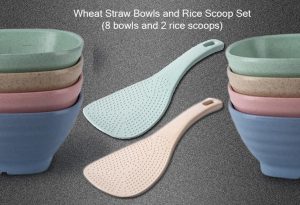
Start a Business -Disposable Tableware from Rice and Wheat Straw
Straw is a farming result comprising of the dry stalks of cereal plants after the grain and waste have been taken out. It makes up about a portion of the yield of cereal harvests, for example, grain, oats, rice, rye, and wheat. Wheat straw is the stalk left over after wheat grains are reaped. Customarily, it has been treated as a waste. In certain nations, farmers bun it, adding to the air contamination and making a general wellbeing risk.
Nonetheless, these stalks have value. These items are predominant in fast-food restaurants, takeaways, yet additionally for aircraft dinners. In private settings, this sort of expendable item has demonstrated exceptionally mainstream with buyers who favor simple and snappy cleanup after gatherings, and so forth Wheat straw contains cellulose which can be separated and reprocessed into various polymers that are frequently called bioplastics. Note that bioplastics are not really compostable and the term bioplastic is now and then inexactly applied.
Many diverse stringy plants can be made into choices to tree-based paper items, most prominently wheat, rice, hemp, flax, and sugar stick. In numerous horticultural cycles, straw is dealt with only as of the farming waste that stays after grain or squeeze is extricated from crops. For World Centric, straw is a significant asset that can be formed into expendable items like plates, take-out compartments, bowls, and so forth
Biodegradable Tableware is the cutlery and ceramics or flatware which is compostable and effectively degradable by the activity of organisms. These are comprised of sugarcane bagasse, bamboo, paper mash, bagels, rice husk, coconut coir, and other expendable material viz. biodegradable plastic.
Related Videos:- Biodegradable Products, Recyclable, Disposable, Eco-Friendly Plastics, Bioplastics, Compostable, Biodegradable Packaging for Food Products
Manufacturing of disposable Table ware:
Biodegradable tableware, as the name proposes, is completely compostable and biodegradable; thus, it is generally utilized internationally to diminish plastic waste and nursery emanations, for example, methane discharges. This sort of silverware can be produced using sugarcane bagasse, bamboo, paper mash, and other expendable material. This tableware is prevalent in strength and is climate agreeable. Biodegradable tableware incorporates food holders and silverware, for example, bowls, plates, cups, and supper plates, which decay within 30 to 60 days in the wake of being disposed of.
Expanding preference for climate-friendly tableware and rising concerns concerning the evil impacts of plastic tableware are boosting the biodegradable tableware market. Rising accentuation on non-poisonous and oil-free is required to drive the interest for Biodegradable Tableware in the private and business sections. Rising extra cash alongside expanding shopper mindfulness about the advantages related to the utilization of biodegradable tableware is required to drive the market.
Related Project:- Eco-friendly Profitable Business Ideas Of Compostable & Disposable Tableware From Rice Straw And Wheat Straw
Moreover, expanding monetary mindfulness about the utilization of plastic and other harmful material tableware, regarding their cost, among purchasers gives them the advantage of decision and all the while makes rivalry in the market to create the best quality items. In India, biodegradable items produced using bamboo were generally utilized in provincial territories; throughout the long term, this pattern has spread to the metropolitan zones also. Notwithstanding, in specific pieces of the globe, this tableware, particularly those produced using bamboo, is costly. Buyer item bundling and expendable eating items made of biodegradable material, for example, corn, sugarcane, husk, and other plant bases have various ecological focal points over non-biodegradable items. These variables combined with rising venture and improvement is foreseen to lift to the market.
The Market Outlook of the industry
The dispensable tableware is predominantly produced using paper, mash, Polyethylene terephthalate, polyethylene, Starch Blends, biodegradable CPLA, PLA, and Talc, and so on the principle uses of dispensable tableware are family and business use. Business use is ruling the end market, involve for about 79.6 % of the piece of the overall industry.
The worldwide expendable tableware market is esteemed at 27.37 billion USD in 2016 and is relied upon to arrive at 29.7 billion USD before the finish of 2020, developing at a CAGR of 1.7% somewhere in the range of 2016 and 2020; while the dispensable flatware deals were 1049 billion USD in 2016 and it will be 1224 billion units in 2020.
Conclusions:
The project report by NPCS on Disposable Tableware from Rice and Wheat Straw- Manufacturing Plant, Detailed Project Report, Profile, Business Plan, Manufacturing Process, Machinery, Raw Materials, Feasibility Study, Investment Opportunities, Cost and Revenue is a report wherein you can become more acquainted with the present and estimate the market. All the information given in the task report is pre-surveyed and checked with the business players.
EVA_Art2021